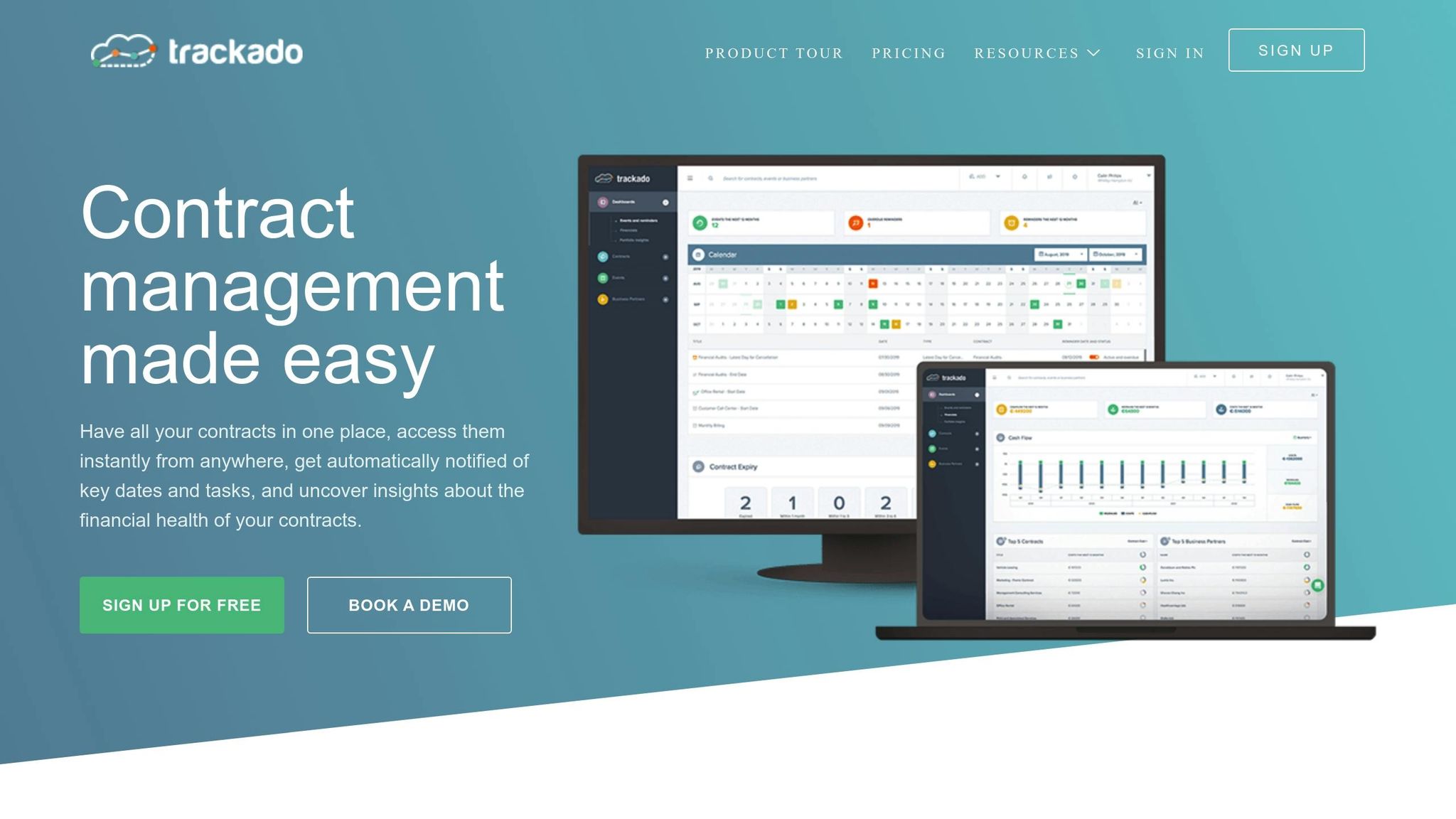
Managing contracts manually? It’s a recipe for missed deadlines, legal risks, and wasted resources. Automating contract management simplifies the process, reduces errors, and ensures compliance with key obligations. Here’s what you need to know:
- Manual contract tracking fails: Deadlines slip, obligations are missed, and scattered storage creates confusion.
- Automation fixes these issues: Centralized dashboards, automated reminders, and real-time tracking help businesses stay on top of renewals, payments, and legal requirements.
- Key benefits include: Fewer errors, faster approvals, easier audits, and better risk management.
For instance, tools like Trackado streamline contract storage, automate workflows, and ensure secure, organized compliance. Automation isn’t just about saving time – it’s about protecting your business from costly mistakes and strengthening vendor and client relationships.
Problems with Manual Contract Management
Managing contracts manually becomes a real headache as the number of agreements grows. The challenges pile up in the form of missed deadlines, scattered information, and clunky processes that slow everything down.
Missed Deadlines and Obligations
Relying on memory or basic tracking tools just doesn’t cut it when you’re juggling multiple contracts. Important dates, like renewal and termination deadlines, often slip through the cracks. Many contracts require notice 30, 60, or even 90 days in advance for renewals or cancellations. Without automated reminders, these critical windows close before anyone notices, leaving businesses stuck with unfavorable terms or scrambling to renegotiate at the last minute.
Payment deadlines are another common stumbling block. Missing them can result in hefty penalties or losing out on early payment discounts. And then there are performance obligations – things like service level agreements, delivery schedules, or compliance requirements. These often have strict deadlines buried within the fine print, and manual tracking systems struggle to keep up. Failure to meet these obligations can lead to financial penalties and strained client relationships.
No Central Oversight
When contracts are scattered across filing cabinets, email threads, shared drives, and individual computers, it’s nearly impossible to get a clear picture of an organization’s responsibilities. This lack of centralized storage creates major blind spots.
The problem becomes worse during staff transitions. If a key employee leaves, their knowledge of critical vendor relationships and upcoming deadlines often leaves with them. Reconstructing this information can take months, leaving the business vulnerable in the meantime.
Departmental silos add to the confusion. Legal might hold signed agreements, finance tracks payment terms, and operations monitors performance requirements. Without a unified system, these teams often work with incomplete or conflicting information. This lack of coordination leads to missed opportunities and makes managing contracts a frustrating maze.
On top of that, fragmented storage makes risk assessment almost impossible. Without a centralized view, organizations can’t easily evaluate their exposure to specific vendors, identify recurring patterns in contract terms, or detect conflicts between agreements. This disorganization wastes time and creates unnecessary risks.
Time-Consuming Processes
Manual contract management eats up valuable time that could be spent on more strategic work. Contract managers often find themselves buried in repetitive tasks – updating spreadsheets, sending reminder emails, and chasing down information from different departments.
Preparing for audits is especially painful. Gathering documentation, checking compliance, and compiling reports becomes a massive undertaking. Staff have to dig through files, piece together timelines, and pull data from multiple sources just to meet basic requirements.
As the number and complexity of contracts grow, so does the workload. For a small business, managing a few simple agreements might take a few hours a month. But for larger organizations with complex portfolios, it can quickly turn into a full-time job. This drain on resources forces businesses to choose between staying on top of compliance or focusing on other important priorities.
And then there’s the issue of reporting and analysis. When so much energy is spent on basic tracking, there’s little time left for deeper insights. Errors from missed deadlines and poor oversight add to the chaos, underscoring the need for a more streamlined, automated solution. A centralized approach could save time, reduce errors, and free up resources for more meaningful work.
How Task Automation Improves Contract Compliance
Task automation takes the hassle out of manual contract management, transforming it into a more efficient and reliable process. Instead of juggling spreadsheets or relying on memory to keep track of deadlines, automated systems handle the heavy lifting – tracking dates, managing workflows, and ensuring nothing slips through the cracks.
Organizations using contract management software have seen their average cycle time from bid to signed agreement reduced by a staggering 80%. By 2025, over 80% of companies plan to adopt automation. It’s clear that manual methods just can’t keep up with the pace of modern business. Automation steps in to create dependable, system-driven processes that work tirelessly, day and night.
Real-Time Tracking of Deadlines and Obligations
Automated contract management platforms take the uncertainty out of tracking deadlines. These systems operate around the clock, sending automatic reminders for critical milestones like renewal dates, deliverables, and compliance checks. They provide instant visibility across your entire contract portfolio.
"Contract management platforms with automation capabilities allow you to assign tasks, set deadlines, and trigger automatic reminders for key milestones – such as renewal dates, deliverables, or compliance checks."
Centralized dashboards offer a single, clear view of contract statuses, upcoming deadlines, and pending tasks.
"Automated systems have centralized dashboards with real-time insights. You can easily see all your contract statuses, deadlines and risks in one area."
For example, if a vendor contract requires 60 days’ notice for renewal, the system will flag this well in advance and send timely reminders to the right team members. This proactive approach minimizes the risk of missed obligations or penalties and helps you avoid unfavorable terms caused by overlooked deadlines. With continuous monitoring, you’re better equipped to streamline approval processes and keep everything on track.
Simplified Approval Workflows
Real-time tracking is just the beginning – automation also simplifies approval workflows, cutting down on human error. Traditional approval processes can be chaotic, with scattered email chains and misplaced documents. Automated workflows eliminate this confusion by creating structured, documented paths for every contract that requires approval.
Digital workflows speed things up by reducing delays and ensuring no steps are missed. Instead of chasing down signatures or approvals manually, the system automatically routes documents to the right people in the correct order. Notifications keep team members informed when it’s their turn to review or approve, while managers can track progress at every step. This task-based system ensures timely completion, maintains a clear audit trail, and moves contracts forward without constant follow-ups.
These workflows also make audit preparation easier by keeping all records organized and accessible, ensuring every required step is documented.
Better Audit Readiness
Automation doesn’t just streamline daily operations – it also strengthens your audit readiness. When an audit rolls around, there’s no need for last-minute scrambling. Centralized platforms keep everything searchable and secure, with features like encryption, role-based access, and detailed audit logs.
The system automatically tracks key deadlines and ensures all agreements meet company standards. Real-time analytics provide dynamic insights into contract performance and compliance, allowing you to address risks before they escalate. By linking contracts to risks, controls, and compliance requirements, these platforms offer a comprehensive view that simplifies compliance across your entire portfolio.
In short, automation turns a traditionally messy and time-consuming process into something far more manageable and reliable.
Key Benefits of Automation for Contract Compliance
Building on the streamlined processes discussed earlier, automation offers crucial advantages that directly tackle common contract compliance challenges. These benefits not only improve efficiency but also help small and medium-sized businesses (SMBs) save time and money.
Fewer Errors and Lower Risk
Relying on manual methods like spreadsheets often leads to missed deadlines and overlooked obligations. Automated systems significantly reduce these risks by taking over routine monitoring tasks and ensuring every contract follows a consistent process.
Here’s a quick look at how automation stacks up against manual methods for handling compliance challenges:
| Compliance Area | Manual Process | Automated Process |
|---|---|---|
| Deadline Tracking | Relies on memory and manual updates | Automated alerts help avoid missed dates |
| Document Storage | Scattered across emails and folders | Centralized repository with fast, accurate search |
| Approval Workflows | Managed through email chains and calls, often unclear | Automated routing with live status updates |
| Audit Preparation | Time-consuming collection and organization of documents | Quick report generation with detailed audit trails |
| Risk Assessment | Reactive, periodic manual reviews | Continuous monitoring with timely risk notifications |
Automated systems also standardize approval processes, using uniform templates and predefined criteria. This not only ensures consistency but also reduces the risk of regulatory issues and contractual disputes, making compliance management much more reliable.
Improved Efficiency and Cost Savings
Automation does more than reduce errors – it frees up valuable time and resources. Manual contract management often requires significant administrative effort, pulling staff away from strategic priorities. Automation simplifies tasks like tracking deadlines, managing approvals, and organizing documents, allowing your team to focus on higher-impact work.
Cost savings come into play as well. By preventing unplanned renewals and ensuring timely action on renewal opportunities, automated systems help avoid unnecessary expenses. For SMBs, this means handling a growing number of contracts without the need to hire additional staff – a clear win for the bottom line.
While efficiency and cost savings are key, automation also brings powerful reporting tools that enhance strategic decision-making.
Complete Documentation and Reporting
Automated systems make compiling contract data for audits and reviews a breeze. With just a few clicks, you can generate detailed reports that provide immediate insights into your contract portfolio.
These systems maintain comprehensive audit trails, logging every action taken on a contract – from edits and approvals to communications. This level of documentation proves invaluable during regulatory audits, legal disputes, or internal reviews.
On top of that, enhanced reporting capabilities allow you to spot trends and recurring issues, such as challenges with specific vendors or contract types. This data-driven approach helps you make informed decisions about vendor relationships, contract terms, and internal workflows. Plus, it offers clear visibility into upcoming expenses and revenue commitments, making budgeting and cash flow management far more effective. All of this strengthens your compliance management efforts even further.
sbb-itb-49df6ae
Trackado: Simplifying Contract Compliance with Automation
Trackado offers a streamlined solution for businesses looking to simplify contract compliance through automation. Designed with small and medium-sized enterprises (SMEs) in mind, this platform combines ease of use with powerful automation tools, making it a go-to choice for organizations aiming to manage contracts more efficiently.
Centralized Contract Storage and Monitoring
Trackado brings all your contracts into one secure, centralized system, allowing you to access your entire portfolio from a single dashboard. No more scattered files or endless searches – everything is organized and easy to find.
The platform’s AI-powered data extraction automatically pulls essential details like dates, dollar amounts, and key terms from uploaded contracts. This eliminates the need for manual data entry, saving hours of administrative work. Once extracted, this data is fed into Trackado’s monitoring system, which keeps tabs on deadlines, renewal dates, and obligations across your contracts.
Users can categorize contracts by partner, department, or type, making it simple to analyze performance or locate specific agreements. The system provides full visibility into costs, revenues, and important dates, giving finance teams the insights they need for better budgeting and cash flow management. With everything in one place, you’ll never be caught off guard by an unexpected renewal or compliance deadline.
Customizable Workflows and Automated Reminders
Trackado adapts to your business processes, offering customizable fields and milestone tracking to suit your specific needs. Whether you’re managing vendor agreements, client contracts, or partnership deals, the system can be tailored to capture the details that matter most to your organization.
Its task-based approval workflows ensure contracts move smoothly through the approval chain. You can set up conditional routing based on contract type or value, define escalation procedures for stalled approvals, and create clear approval hierarchies. Automated notifications keep everyone informed – whether it’s a legal review, executive sign-off, or a renewal deadline, the right people get timely alerts with all the context they need to act. This reduces the endless back-and-forth communication that often slows down contract management.
Enterprise-Grade Security and Scalability
Although Trackado is built for SMEs, it doesn’t skimp on security. The platform is hosted in secure European data centers and uses SSL encryption to protect sensitive information. This ensures compliance with data protection regulations while safeguarding your contracts.
Trackado grows with your business. Whether you’re starting with a free plan for a small portfolio or scaling up to enterprise-level features, the platform adapts to your needs without compromising functionality. The integrated e-signing feature simplifies the contract lifecycle even further, allowing you to execute agreements directly within the platform. Export options and seamless integration make it easy to manage compliance as your contract volume increases.
With its robust automation tools and user-friendly design, Trackado makes contract compliance less of a headache and more of a streamlined process.
Best Practices for Implementing Automated Contract Compliance
To get the most out of automated contract compliance, you need more than just good tools – you need a smart approach. Success depends on careful planning, thoughtful setup, and ongoing fine-tuning to make sure your automation works effectively for your business.
Start with a Complete Contract Inventory
Before you jump into automation, you need a clear understanding of your current contracts. Building a complete contract inventory is the first step to successful compliance automation. This means tracking down every contract your organization has signed, no matter where it’s stored or who manages it.
Reach out to departments like legal, procurement, sales, HR, and facilities management – contracts are often scattered across teams. During this process, document key details such as contract location, type, the counterparty, critical dates, and current status.
Pay extra attention to contracts that could pose serious risks if obligations are missed. These might include vendor agreements, contracts tied to service-level agreements, real estate leases, or any with automatic renewal clauses. For each, note the specific compliance requirements like reporting obligations, performance metrics, or industry-specific regulations.
Once you’ve gathered all your contracts, focus on digitizing them – starting with the ones that are high-risk or frequently referenced. Contracts with upcoming deadlines or renewals should be uploaded to your automation platform first. A well-organized inventory makes your automated compliance system far more efficient.
Set Up Workflows and Alerts
Effective automation starts with clear workflows tailored to your contract types. Map out your current approval processes and identify any bottlenecks. Then, align your workflows with both internal needs and regulatory requirements.
For example, platforms like Trackado allow you to create conditional workflows based on contract value thresholds. A contract under $10,000 might only need departmental approval, while anything over $50,000 could require an executive sign-off. This setup avoids unnecessary delays for smaller agreements while ensuring proper oversight for larger ones.
Alerts are key to staying on top of compliance deadlines. Set up reminders for critical dates – 90, 60, 30, and 7 days before deadlines are common intervals. These alerts give your team enough time to prepare for renewals, gather necessary documentation, or allocate budgets. For contracts with recurring reporting requirements, configure alerts that match your internal reporting cycles.
It’s also important to consider the specific regulations your business operates under. For instance, healthcare companies might need alerts for HIPAA reviews, financial firms for regulatory deadlines, and government contractors for certification renewals. Build these requirements into your workflows from the beginning to avoid trying to add them later. A proactive setup ensures the system meets your needs and sets the stage for effective staff training.
Train Staff and Monitor Results
Even the best automation system won’t work if your team doesn’t know how to use it. That’s why training and consistent data entry standards are so important. Regularly monitor performance metrics and adjust workflows based on what you learn.
Offer role-specific training so every team member knows how to use the system effectively. Legal teams should focus on setting up approval workflows and tracking compliance requirements, while finance teams might need training on generating reports for budgeting and cost analysis. Administrative staff should learn how to manage data entry and maintain consistent document formatting.
Consistency is critical – establish clear data entry standards early on. This includes using uniform naming conventions for contract types, consistent date and dollar amount formats, and agreed-upon terms for contract statuses. Inconsistent data can undermine the effectiveness of your system, so it’s worth the time to get this right from the start.
Track your system’s performance with regular reporting and analysis. Monitor metrics like the percentage of contracts with complete data, how quickly contracts are entered into the system after execution, and compliance with deadlines. Many organizations see improvements within the first 90 days, but ongoing monitoring helps identify areas for further refinement.
Hold monthly reviews to evaluate workflows and look for patterns, like repeated missed deadlines or approval delays. Adjust your automation rules as needed. User feedback is invaluable during these reviews – those who use the system daily often have the best insights into what’s working and where changes are needed. By focusing on training, monitoring, and continuous improvement, your automated compliance system will keep delivering value over the long term.
Conclusion: The Future of Compliance with Task Automation
Managing contracts manually comes with its share of risks – missed deadlines, financial penalties, and overlooked opportunities. These challenges make staying compliant more than just a task; it’s a critical part of running a successful business. The key to overcoming these hurdles lies in task automation, which is reshaping how organizations handle their contractual responsibilities.
Automation minimizes human errors, speeds up approval processes, and keeps detailed audit trails. This allows teams to shift their energy toward strategic goals rather than getting bogged down in administrative tasks. The payoff? Fewer mistakes, lower costs, and complete transparency into contract performance across the board. A standout example of this shift is Trackado.
Trackado showcases the power of automation with features like centralized contract storage, automated reminders, and top-tier security. These tools ensure that no critical obligation falls through the cracks, addressing the very issues that manual processes often create.
Businesses that adopt automation are better equipped to manage increasing contract volumes and adapt to changing regulations – all without piling on extra administrative work. The road ahead for contract compliance is clear: automation offers a smarter, more proactive way to manage obligations effectively.
FAQs
How does task automation help prevent missed contract deadlines and obligations?
Automation takes the hassle out of managing contract deadlines and obligations by keeping tabs on critical dates, approvals, and deliverables in real-time. With automated reminders and alerts, the right team members are always in the loop, eliminating the need for constant manual follow-ups.
This streamlined approach cuts down on oversights, reduces the chance of human error, and ensures your team stays compliant with contractual requirements. Staying ahead of deadlines not only shields your organization from potential penalties or breaches but also strengthens business relationships by consistently meeting commitments on schedule.
What steps should a business take to successfully automate contract compliance?
To make contract compliance automation work effectively, begin by taking a close look at your current contract management process. Pinpoint any bottlenecks or areas where things could run more smoothly. From there, create standardized contract templates and assign clear roles to everyone involved, so responsibilities are well-defined.
Use automated reminders to keep track of critical dates, approvals, and obligations – this helps ensure that no key tasks slip through the cracks. Link automation tools to systems you already rely on, like your accounting software or CRM, to create a more seamless workflow. Make it a habit to conduct regular audits of your processes and provide ongoing training for your team. This approach helps you get the most out of automation while staying on top of compliance requirements.
How does task automation improve contract compliance, and what features should a contract management tool have to support this?
Task automation plays a key role in improving contract compliance by simplifying processes like tracking deadlines, managing responsibilities, and securing necessary approvals. By cutting down on manual tasks, it reduces the chances of errors, increases transparency, and helps ensure that important milestones are achieved on schedule.
When choosing a contract management tool, prioritize features that make your life easier. Look for a centralized repository to keep all your contracts accessible in one place, automated reminders to stay on top of critical dates and obligations, audit trails to monitor changes and approvals, and customizable workflows that can align with your organization’s specific needs. These tools not only help you stay compliant but also reduce risks and give you greater control over your contracts.






